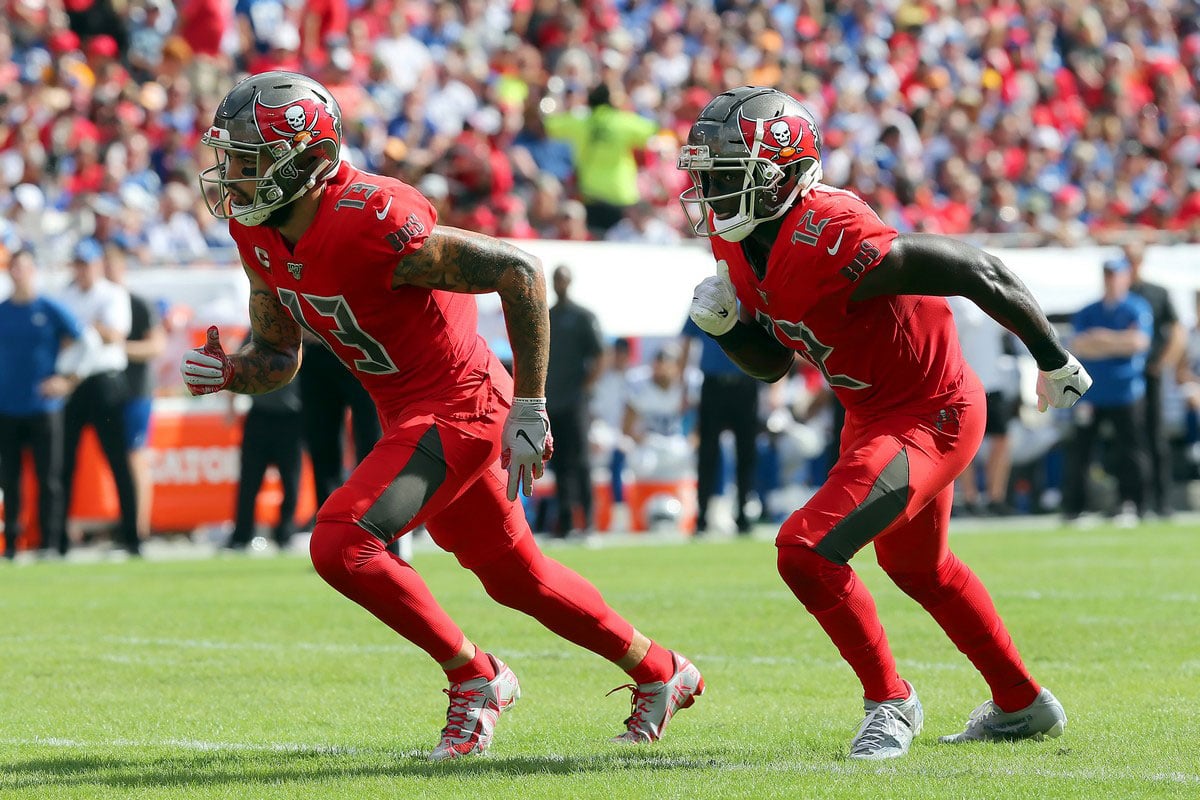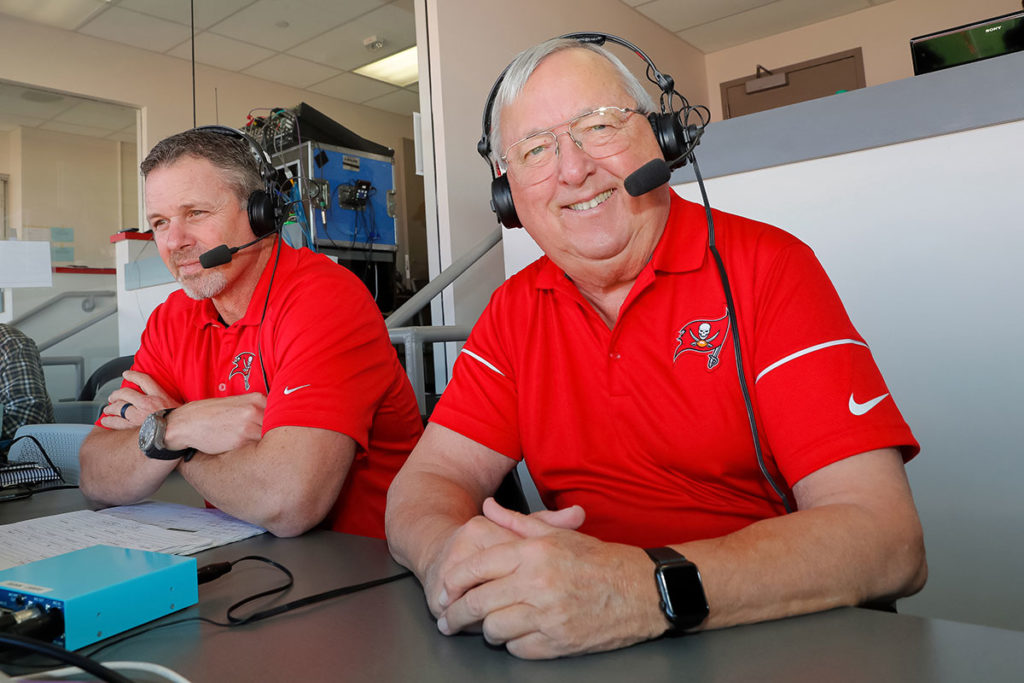FAB 2. 5 Things That Will Happen For The Bucs In 2020
I offered up five predictions about things that will happen for the Bucs in 2020 in Fab 1. Now it’s time for me to list five things that won’t happen for Tampa Bay in 2020.
Tampa Bay’s Run Defense Won’t Be No. 1 Again
The Buccaneers led the league in rushing defense last year – and by a healthy margin – allowing just 73.8 yards per game. According to Buccaneers.com, that was the 13th-lowest rushing yards allowed in a single season in league history. Tampa Bay surrendered just 1,181 yards on the ground, which was the best in franchise history, in addition to a team-best 3.26-yard average.
With all 11 starters returning the Bucs should have a chance to repeat as the league’s top run defense, but Tampa Bay will face a far greater stable of running backs in 2020 than it did when it only allowed one 100-yard rusher last year. Aside from facing New Orleans’ Alvin Kamara, Carolina’s Christian McCaffrey and Atlanta’s Todd Gurley in the NFC South, the Bucs will battle five 1,000-yard rushers this season, including Minnesota’s Dalvin Cook, Denver’s Phillip Lindsay, Green Bay’s Aaron Jones, Las Vegas’ Josh Jacobs and New York’s Saquon Barkley. The Chargers have a talented one-two punch in Melvin Gordon and Austin Ekeler.
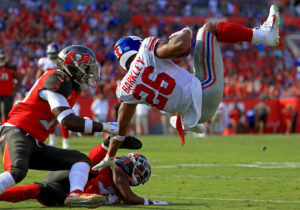
Giants RB Saquon Barkley – Photo by: Getty Images
While the Bucs did a good job neutralizing McCaffrey, Kamara and Barkley last year, in addition to Gurley when he played for the Rams, it’s a new season. Tampa Bay’s opponents have 16 games in which to study Todd Bowles’ scheme and his starters to identify weaknesses.
The Bucs’ success against the run was also a function of teams picking on Tampa Bay’s secondary as the team started several rookies, including cornerbacks Sean Murphy-Bunting and Jamel Dean and safety Mike Edwards, especially in the first half of the season. The Bucs played better against the pass down the stretch, not allowing a 300-yard passer over the second half of the season.
If that improvement continues in 2020 teams will take a more balanced approach in attacking Bowles’ defense. The Bucs surrendered 270.1 passing yards per game last year, which ranked 30th in the league. If that number improves and Tampa Bay allows fewer passing yards, it is only logical to suggest that the Bucs will surrender more rushing yards as a result.
Barrett Won’t Lead the Bucs In Sacks
Tampa Bay’s free agent acquisition of outside Shaquil Barrett was one of the most obscure signings in the league last offseason. Barrett inked a one-year, prove-it contract with the Bucs worth $4 million and thrived in Bowles’ blitzing 3-4 scheme, leading the league with a career-high 19.5 sacks, which broke Warren Sapp’s franchise record of 16.5 sacks set in 2000.
Barrett started off the season red hot with nine sacks in the first four games, and ended the year with a bang against Atlanta, notching three more sacks. After a record-breaking performance the Bucs used the franchise tag on Barrett and will spend the 2020 season working with Drew Rosenhaus on a multi-year contract extension that can be executed next offseason.
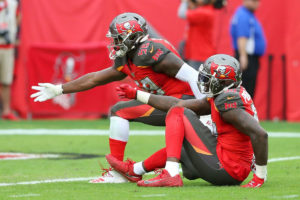
Bucs OLBs Jason Pierre-Paul and Shaq Barrett – Photo by: Cliff Welch/PR
While Barrett enjoyed a breakout season in 2019, he’ll be a marked man in 2020 and won’t be sneaking up on any opponent. That should greatly benefit outside linebacker Jason Pierre-Paul, who I believe will lead Tampa Bay in sacks with 15. Pierre-Paul had 12.5 sacks in his first season two years ago to lead the team and break the Bucs’ drought of not having a double-digit sacker since Simeon Rice last accomplished that feat in 2005.
Pierre-Paul missed the first six weeks of the 2019 campaign after fracturing a vertebrae in his neck during an offseason car crash. He returned to action and recorded 8.5 sacks over the final 10 games of the season, notching five sacks in the final two games to end 2019 on a high note.
Barrett and Pierre-Paul teamed up to produce 28 of the Bucs’ 47 sacks last year, and it’s quite possible that Tampa Bay’s dynamic duo does that again. Only this time it will be Pierre-Paul, who is also a deadly pass rusher inside on nickel defense, leading the way with 15 and Barrett notching 13.
RoJo Won’t Be A 1,000-Yard Rusher
The Bucs are hoping that Ronald Jones II can live up to his second-round draft billing from three years ago and can establish himself as a 1,000-yard rusher in the NFL. After a dreadful rookie season in which he averaged 1.9 yards per carry and rushed for just 44 yards and one touchdown, Jones enjoyed a breakout season in 2019, rushing for a team-high 724 yards and six touchdowns, while averaging a solid 4.2 yards per carry.
Jones eventually beat out Peyton Barber for the starting role by midseason and ended the year strong with 183 yards combined and one touchdown over the last two games of the season. Jones also showed big-play ability with a career-long 49-yard run against Houston, followed by a 33-yard jaunt against Atlanta in Week 17.
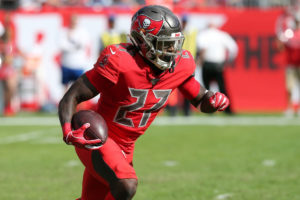
Bucs RB Ronald Jones II – Photo by: Cliff Welch/PR
But what gives me pause about Jones being able to emerge as a 1,000-yard rusher is that it took him two full years to even post his first 100-yard rushing game, which came against the Falcons in the season finale where he carried the ball 11 times for 106 yards (9.6 avg.). Jones continued to split time with Barber all the way until the end of the 2019 season, and while Barber wasn’t re-signed, the team did draft Ke’Shawn Vaughn in the third round this past April to replace him.
That means Jones will still cede some carries and likely won’t be a 20-carry-per-game back in 2019. In fact, Jones only had five games in which he had more than 12 carries last year, and there nine games in which he failed to rush for more than 36 yards.
What could help Jones prove me wrong is that he’s been training hard this offseason to be able to increase his workload in 2020. Last year, Jones gained about 15 pounds of muscle and bulk, especially in his lower body, which aided his tackle-breaking ability. The fact that the Bucs trailed in nearly half of their games also led to more passing plays than running plays in 2019. If Tom Brady can stay away from interceptions and the Bucs have the lead more often throughout the game, that could lead to more fourth quarter carries for Jones to run Tampa Bay to victory. The guess here is that Jones shows improvement and tops 900 yards rushing, but falls short of 1,000 yards in 2020.
Brate Won’t Be Much Of A Factor In 2020
Bucs tight end Cameron Brate carved out a niche for himself as the safety blanket for former Tampa Bay quarterback Jameis Winston, especially in the red zone. Brate caught 27 touchdowns over the past five years, which ranks among the league leaders at his position. His career-high was eight in 2016, followed by back-to-back seasons with six touchdowns, and then four last year.
But Winston has been replaced by Brady, and he already has a favorite tight end in Rob Gronkowski from his days in New England. While the Bucs are expected to run more 12 personnel – one running back, two tight ends, two receivers – in 2020, that could come at Brate’s expense as Gronkowski and tight end O.J. Howard, the team’s first-round pick in 2017, figure to be the starters in that formation.
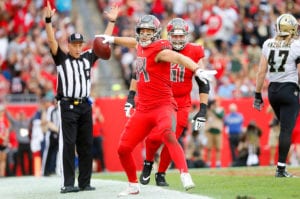
Bucs TE Cameron Brate – Photo by: Cliff Welch/PR
The fast and athletic Howard regressed some in 2019, but ended the season strong, and still produced 34 catches for 459 yards (13.3 avg.) and one touchdown. Brate had 36 catches for 311 yards and four scores. Back, hip and rib injuries have robbed Brate of his effectiveness over the last couple of years. After averaging 12.3 yards per catch in 2017, Brate’s yards per catch average slipped to 9.6 in 2018 and down to 8.6 last year.
Brate is more of a receiving tight end than he is a blocker, and he could see some of his snaps reduced when the team wants to run the ball out of two tight end sets. In those instances, Gronkowski and third-year tight end Antony Auclair, a blocking specialist, will be on the field.
If Brate comes anywhere close to last year’s production in 2020 it will be due to the fact that Gronkowski suffered an injury and/or Howard was also hurt or ineffective, as he was at times last season.
Evans Won’t Make The Team In 2020
The Buccaneers have been frustrated with Justin Evans, the team’s starting free safety from 2017-18, and his chances of making the team’s 55-man roster in 2020 appear to be slim. Evans has battled toe and heel problems since midway through the 2018 season, and saw that year end prematurely on injured reserve.
Tampa Bay hoped he would recover during the offseason and be able to compete in training camp, but that never materialized, and Evans’ gamble that rest – rather than surgery – didn’t pay off. Evans returned to practice for a week prior to the final preseason game, but couldn’t go as the pain returned. He finally opted for surgery on both of his heels and missed the 2019 campaign.
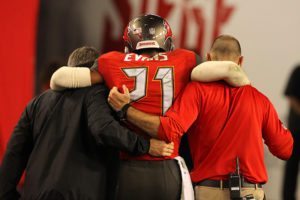
Bucs S Justin Evans – Photo by: Cliff Welch/PR
During his absence, young safeties Jordan Whitehead and Mike Edwards, last year’s third-round pick, got valuable playing time and showed improvement, and veteran Andrew Adams was also re-signed. The fact that the Bucs spent a second-round pick on free safety Antoine Winfield, Jr. is evidence that the team isn’t counting on Evans to return to action in 2020.
Even if Evans is healthy enough to take the field in training camp, can his level of play return to the level it was prior to his injury? And can he shake off the rust to be able to beat out Whitehead, Edwards, Adams and D’Cota Dixon, a promising young safety whose season ended in training camp due to a shoulder injury, for a roster spot? The fact that the Bucs drafted Winfield so high suggests to me that the answer is no.
 Do you like this edition of SR’s Fab 5? Please donate to PewterReport.com today to help our business overcome the financial hardship due to COVID-19. One-time donations start as low as $10 – or you can donate monthly for as low as $3 per month. Thank you for your support! CLICK HERE TO DONATE
Do you like this edition of SR’s Fab 5? Please donate to PewterReport.com today to help our business overcome the financial hardship due to COVID-19. One-time donations start as low as $10 – or you can donate monthly for as low as $3 per month. Thank you for your support! CLICK HERE TO DONATE
Scott Reynolds is in his 30th year of covering the Tampa Bay Buccaneers as the vice president, publisher and senior Bucs beat writer for PewterReport.com. Author of the popular SR's Fab 5 column on Fridays, Reynolds oversees web development and forges marketing partnerships for PewterReport.com in addition to his editorial duties. A graduate of Kansas State University in 1995, Reynolds spent six years giving back to the community as the defensive coordinator/defensive line coach for his sons' Pop Warner team, the South Pasco Predators. Reynolds can be reached at: [email protected]

